


LOUIS XVI SUMMONS THE STATES-
xxxxxIn France, the wars of
Louis XIV and XV, together with their highly expensive court at
Versailles, had put the country into serious financial difficulties.
The privileged nobles and higher clergy were exempt taxes, so the
burden fell on the common people. They also had to pay a tithe to
the Church, duties on their food, and give service to their lord.
Thus when the weak Louis XVI came to the throne in 1774, his country
faced bankruptcy, and there was growing unrest among its people.
Attempts to reform the tax system failed and, following the cost of
French intervention in the War of American
Independence, the banks refused to give
further loans. As a result, in 1788 Louis was forced to call the States General. The three
sections or “estates” of this parliament -
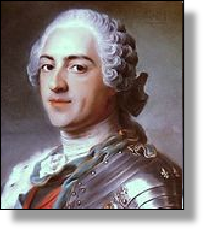 xxxxxBy the beginning of the 1770s, France was tottering on
the very brink of financial and political bankruptcy. The reign of
the Louis XIV, brilliant and successful though it had appeared to
be, had bled the country white by its long series of wars, and the
extravagance of its magnificent court at Versailles. At the same
time a mania for centralised control had given absolute power to the
monarchy, destroyed the political authority of the nobles, and left
a yawning gap in the social system between the privileged élite -
xxxxxBy the beginning of the 1770s, France was tottering on
the very brink of financial and political bankruptcy. The reign of
the Louis XIV, brilliant and successful though it had appeared to
be, had bled the country white by its long series of wars, and the
extravagance of its magnificent court at Versailles. At the same
time a mania for centralised control had given absolute power to the
monarchy, destroyed the political authority of the nobles, and left
a yawning gap in the social system between the privileged élite -
xxxxxAt the heart of the problem was the tax system, unashamedly based on social injustice. By their birth or status, the nobility and the higher clergy were exempt from the government tax, the taille. Thus almost the entire nation’s tax burden was borne by the 25 million common people. They, in addition, were required to pay a tithe, levied by the Church, together with duties on goods, including food. When no further tax could be squeezed out of the underprivileged, then the debt was left to accumulate. As Louis XV realised only too well, after him would come the “déluge”.
xxxxxBut within this mass of
common people -
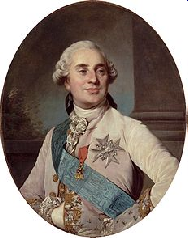 xxxxxThus when the hapless Louis XVI (illustrated) came to the throne in 1774, he inherited a huge
national debt, an annual deficit which he had little hope of
reducing, and a growing, grass-
xxxxxThus when the hapless Louis XVI (illustrated) came to the throne in 1774, he inherited a huge
national debt, an annual deficit which he had little hope of
reducing, and a growing, grass-

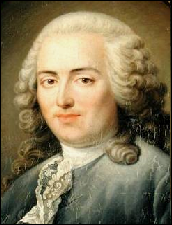 xxxxxThexfirst of these ministers
was Anne Robert Turgot
(1727-
xxxxxThexfirst of these ministers
was Anne Robert Turgot
(1727-
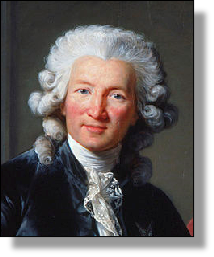 xxxxxThusxthe spending continued and
the debt increased. By the time another able minister, the economist
Charles Alexandre de Calonne
(1734-
xxxxxThusxthe spending continued and
the debt increased. By the time another able minister, the economist
Charles Alexandre de Calonne
(1734-
xxxxxIn fact, the enormous cost
of French participation in the American War of Independence, met by
loans, proved the last straw. In 1787 the banks refused to lend the
king more money, and the government of the country was paralysed.
Amid unrest throughout the country, and a growing demand for reform
-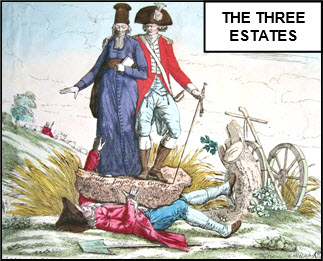 ay.
In truth, this was an assembly from a bygone feudal day. Made up of
three distinct sections or “estates” of the community -
ay.
In truth, this was an assembly from a bygone feudal day. Made up of
three distinct sections or “estates” of the community -
xxxxxOn Necker’s advice, the “new and improved” States General was to provide greater voting power for the commoners (the “Third Estate”) in recognition of their overwhelming majority in the country. They were to have 600 members, equal to the strength of the other two estates combined. But, this apart, very little was done by way of preparation. No comprehensive plan was drawn up for constitutional reform, nor any directions laid down for the guidance of an assembly of 1200 inexperienced representatives. And, worst of all, no decision was made on the vital question as to whether the three estates should meet separately (giving an advantage to the nobility and clergy), or as one body (an arrangement in favour of the commoners).
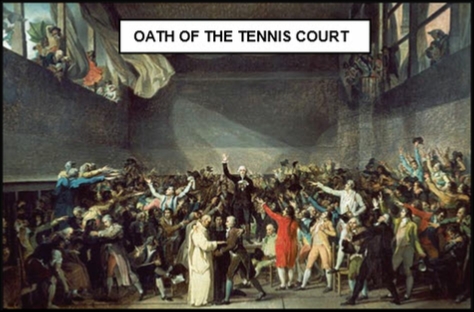 xxxxxWhen the States General assembled at Versailles in May
1789, hopes ran high, but it was on this very point -
xxxxxWhen the States General assembled at Versailles in May
1789, hopes ran high, but it was on this very point -
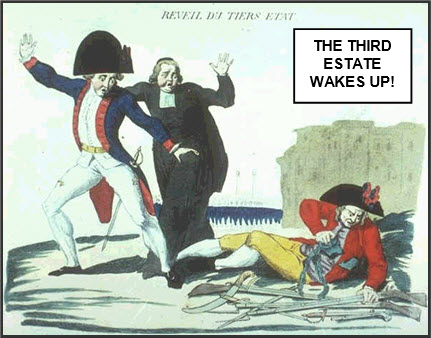 xxxxxIn this new governing body the commoners, with the
support of a number of liberal nobles and clergy, had a clear
majority, but their attempts to draw up a new political and social
order were hampered by a serious lack of practical experience.
Furthermore, there were diverging views as to the best course of
action to be taken, led by men such as the Marquis de Lafayette, who
had fought for the cause of freedom in North America, and the able
but controversial Comte de Mirabeau, who favoured some form of
constitutional monarchy. In such circumstances the impatience for
reform spilled out onto the streets. For some time city mobs had
murdered government officials, and peasants had plundered the
castles of their masters. Now protest became more frequent and
violent, led by organised agitators and extremists. Then, as we
shall see, in July 1789
attempts by the king to control such disorder by force only served
to inspire a violent, popular uprising in Paris -
xxxxxIn this new governing body the commoners, with the
support of a number of liberal nobles and clergy, had a clear
majority, but their attempts to draw up a new political and social
order were hampered by a serious lack of practical experience.
Furthermore, there were diverging views as to the best course of
action to be taken, led by men such as the Marquis de Lafayette, who
had fought for the cause of freedom in North America, and the able
but controversial Comte de Mirabeau, who favoured some form of
constitutional monarchy. In such circumstances the impatience for
reform spilled out onto the streets. For some time city mobs had
murdered government officials, and peasants had plundered the
castles of their masters. Now protest became more frequent and
violent, led by organised agitators and extremists. Then, as we
shall see, in July 1789
attempts by the king to control such disorder by force only served
to inspire a violent, popular uprising in Paris -
xxxxxIncidentally, the Oath of the Tennis Court read:
We swear never to separate ourselves from the National Assembly, and
to reassemble wherever circumstances require, until the constitution of
the realm is drawn up and fixed upon solid foundations.
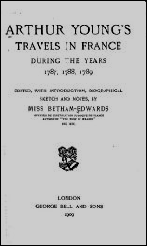 Xxxxx…… And
to ensure that the event was recorded for prosperity, the Assembly
invited the French neo-
Xxxxx…… And
to ensure that the event was recorded for prosperity, the Assembly
invited the French neo-
xxxxx…… The pitiful state of France at this time was vividly described by the Englishman Arthur Young, who travelled extensively across France during the years 1787 to 1789. A writer on agriculture, he reported that there was widespread poverty, misery and discontent among the peasantry. He later put his findings on paper in his Travels in France, published in two volumes in 1792.
Acknowledgements
Louis XV: by the
French painter Maurice Quentin de la Tour (1704-
G3b-


